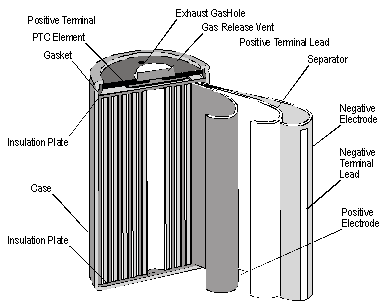<< Previous page INDEX Next page >>
3. The Battery Pack
In the 1700 and 1800s, cells were encased in glass jars. Later, larger batteries were developed that used wooden containers. The inside was treated with a sealant to prevent electrolyte leakage. With the need for portability, the cylindrical cell appeared. After World War II, these cells became the standard format for smaller, rechargeable batteries.
Downsizing required smaller and more compact cell design. The button cell, which gained popularity in the 1980s, was a first attempt to achieve a reasonably flat geometry, or obtain higher voltages in a compact profile by stacking. The early 1990s brought the prismatic cell, which was followed by the modern pouch cell.
This chapter addresses the cell designs, pack configurations and intrinsic safety devices. In keeping with portability, this book addresses only the smaller cells used for portable batteries.
3.1 The Cylindrical Cell
The cylindrical cell continues to be the most widely used packaging style. The advantages are ease of manufacture and good mechanical stability. The cylinder has the ability to withstand high internal pressures. While charging, the cell pressure of a NiCd can reach 1379 kilopascals (kPa) or 200 pounds per square inch (psi). A venting system is added on one end of the cylinder. Venting occurs if the cell pressure reaches between 150 and 200 psi. Figure 3-1 illustrates the conventional cell of a NiCd battery.
Figure 3-1: Cross-section of a classic NiCd cell.
The negative and positive plates are rolled together in a metal cylinder. The positive plate is sintered and filled with nickel hydroxide. The negative plate is coated with cadmium active material. A separator moistened with electrolyte isolates the two plates. Design courtesy of Panasonic OEM Battery Sales Group, March 2001.The cylindrical cell is moderately priced and offers high energy density. Typical applications are wireless communication, mobile computing, biomedical instruments, power tools and other uses that do not demand ultra-small size.
NiCd offers the largest selection of cylindrical cells. A good variety is also available in the NiMH family, especially in the smaller cell formats. In addition to cylindrical formats, NiMH also comes in the prismatic cell packaging.
The Li-ion batteries are only available in limited cells sizes, the most popular being the 18650. ‘Eighteen’ denotes the diameter in millimeters and ‘650’ describes the length in millimeters. The 18650 cell has a capacity of 1800 to 2000mAh. The larger 26650 cell has a diameter of 26 mm and delivers 3200mAh. Because of the flat geometry of the Li-ion polymer, this battery chemistry is not available in a cylindrical format.
Most SLA batteries are built in a prismatic format, thus creating a rectangle box that is commonly made of plastic materials. There are SLA batteries, however, that take advantage of the cylindrical design by using a winding technique that is similar to the conventional cell. The cylindrical Hawker Cyclone SLA is said to offer improved cell stability, provide higher discharge currents and have better temperature stability than the conventional prismatic design.
The drawback of the cylindrical cell is less than maximum use of space. When stacking the cells, air cavities are formed. Because of fixed cell size, the pack must be designed around the available cell size.
Almost all cylindrical cells are equipped with a venting mechanism to expel excess gases in an orderly manner. Whereas nickel-based batteries feature a resealable vent, many cylindrical Li-ion contain a membrane seal that ruptures if the pressure exceeds 3448 kPa (500 psi). There is usually some serious swelling of the cell before the seal breaks. Venting only occurs under extreme conditions.
